|
From this day to the ending of the world...
We in it shall be remembered...
We gallant few, we band of brothers.
For he today that sheds his blood with me
Shall be my brother.
- William Shakespeare, Henry
V
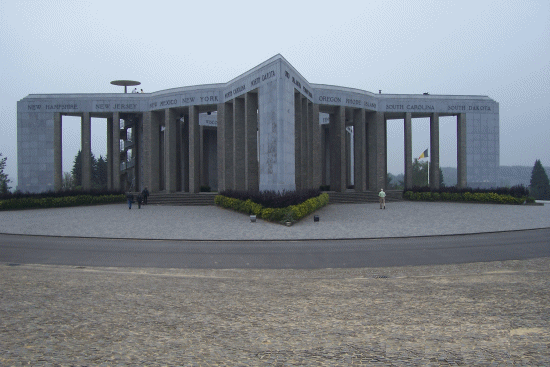 |
Sunday 17 September 2006 - I was in Luxembourg because my
cousin had his birthday with a BBQ. Also my parents came
what I didn't expect. This was also the day that we went to
Bastogne. Driving back to the Netherlands we stopped in
Bastogne. To visit this place called "Le Mémorial du
Mardasson".Bastogne is a city in Belgium in the middle of
the Ardennes.
When you enter the city centre there is on the market place
a statue of a American General Anthony Clement McAuliffe.
For his action's in Bastogne he received the Distinguished
Service Cross. He died at 11 Augustus 1975.
The town Bastogne is also known as "Nuts City!".
The German army wanted the surrender of the American army.
General McAuliffe responded with the words "Nuts!" (go to
hell!). This battle started 16 December 1944 and ended 27
January 1945. The title of battle was "Battle of the Bulge"
to stop the German offensive of code name "Wacht am Rhein"
which began on 16 December 1944.
Bastogne is complete re-build after the war. A few
buildings are still standing there with the memories of the
war.
|
| Belgium-American memorial on the hill of
Mardasson. The monument was inaugurated on the 16th July
1950, in the presence of highly respected Belgium and
American dignitaries; delegations from England, France, the
Netherlands and Luxembourg reinforced the international
character of the event. It goes without saying that many
veterans associations were present, not to mention the
architect Mr. Georges Dedoyard, laureate of a competition
for the project and the contractor Mr. Félicien Calay.
A sealed parchment, signed by various Belgian and
American dignitaries, is to be found in the foundations. The
Memorial is shaped to represent the star of freedom, with
five points, each one measuring 31 meters. The central
atrium's diameter is 20 meters with a height of up to 12
meters, the summit is encompassed by a circular gallery
leading to the orientation tables (scale models showing
different stages of the battle), one for each point of the
star. The names of the 48 states which then made up the
United States are engraved on the crown. Around the outside,
badges from the main battalions to have participated in the
Battle of the Saillant can be found. On the inner wall the
battle's progression is explained in English and in ten
paintings.
A crypt was also dug in the rock; a reminder of the
sacrifice made by the 76,890 Americans heroes killed,
injured or reported missing in the battle. Three altars are
dedicated respectively to the catholic, protestant and
Jewish religions. The beautifully colored mosaics are by the
artist Fernand Léger.
At nightfall, when floodlit, the Memorial stands out
majestically. |
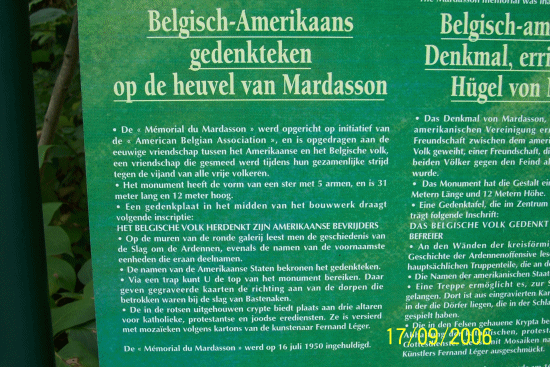 |
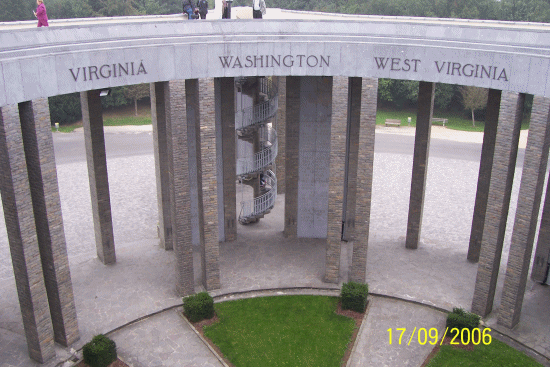 |
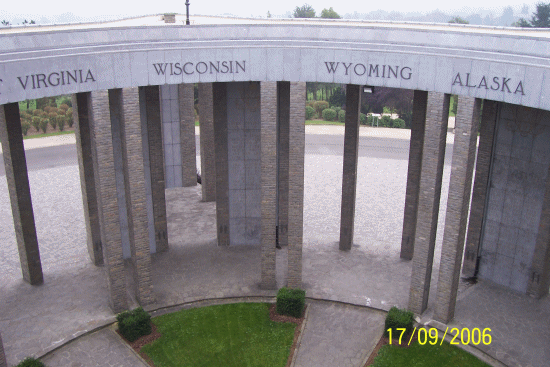 |
| These are some pictures I took from the
inside of the Memorial to give you a impression how the
inside looks like. On the first picture you see the stairs
to go up on the memorial. This stairs is the 4th point of
the memorial.
On every point there is a tablet of the area to where you
look to. Every city or town is also there on the tablet. I
explain this later.
The picture below here is the middle point of the
memorial with a tablet also. The story of that you can read
next to the picture with also the text of it. |
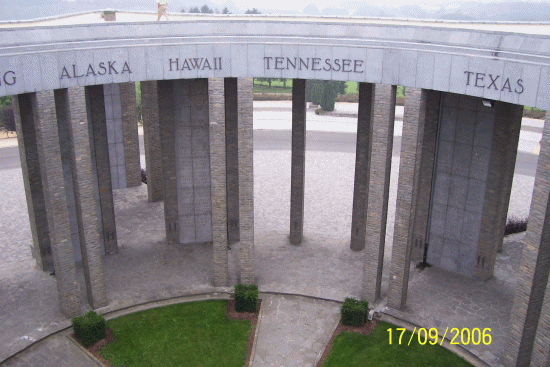 |
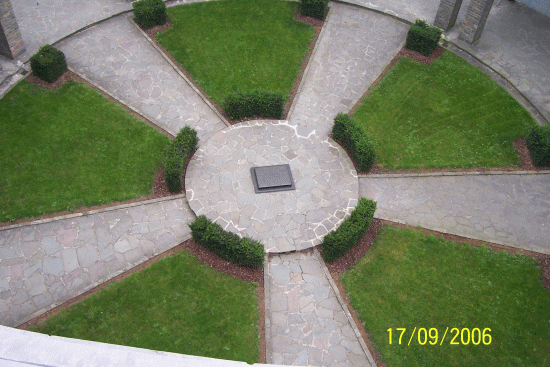 |
On the 4th July 1946, in what was to
become the Memorial's central point, a little earth was
removed and placed in a casket, which was then sealed in the
United States Ambassador's presence and sent by special
plane (a Sabena DC4) to Washington. A Belgian delegation,
led by the Minister of Defense, handed over the sacred
casket to the then president of the United States, Harry
Truman. It was above this central point that the stone
bearing the following inscription would later be placed.
LIBERATORIBUS AMERICANIS
POPULUS BELGICUS MEMOR
4. VII. MCMXLVI
(The Belgian people remember their American liberators -
4th July 1946) |
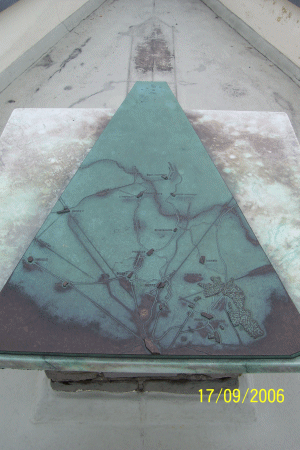 |
Tablet 1 This is the 1st point.
The city's here are:
Foy (B)
Noville (B)
Bourcy (B)
Longvilly (B)
Bizôry (B)
Mageret (B)
Wardin (B)
Neffe (B)
Benonchamps (B)
Niederwampach (L)
Oberwampach (L) |
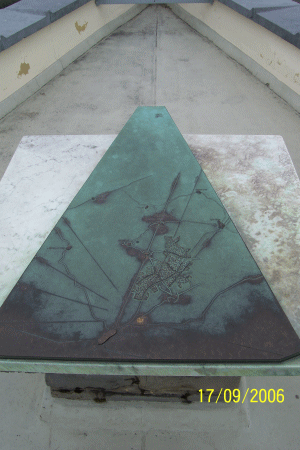 |
Tablet 2 This is the 2nd point.
The city's here are:
Bertogne (B)
Longchamps (B)
Foy (B)
Noville (B)
Bourcy (B) |
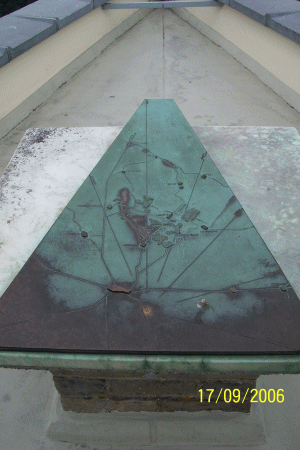 |
Tablet 3 This is the 3rd point.
The city's here are:
Chenogne (B)
Flamierge (B)
Champs (B)
Givry (B)
Longchamps (B)
Bertogne (B) |
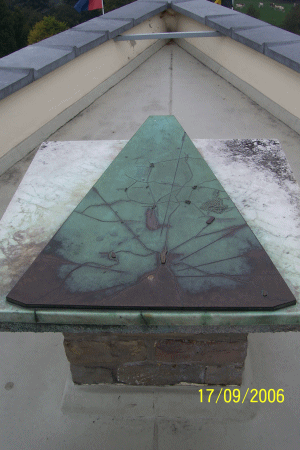 |
Tablet 4 This is the 4th point.
The city's here are:
Chenogne (B)
Sibret (B)
Morhet (B)
Hompré (B)
Hollange (B)
Wardin (B) |
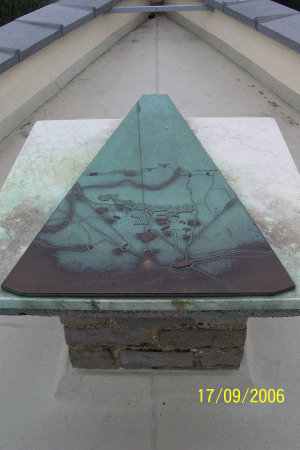 |
Tablet 5 This is the 5th
point.
The city's here are:
Mont (B)
Marvie (B)
Wardin (B)
Benonchamps (B)
Bras (B)
Hompré (B)
Villers-La-Bonne-Eau (B)
(B) = Belgium
(L) = Luxembourg |
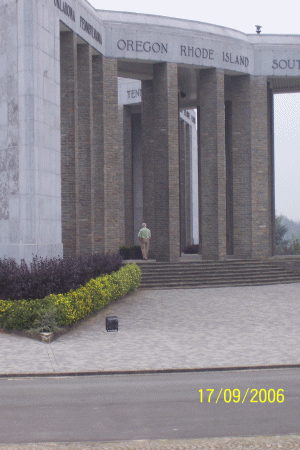 |
The person who walks
there is my dad.When you walk there you sure get the
impression "Here was something big going where many people
wounded or died".
I have then respect for all those people who fought for
our freedom in Europe.
If this was not there then Germany had won the war. What
or how Europe looks like I don't know and don't think about
it. |
| This is the freedom star. It's hanging on
every pillar with under it the Divisions who has taken part
of "Battle of the Bulge". I have from every pillar a picture
and will put some text next to it with all the Division's.
Every year around 30th of May and 22nd of December there is
a memorial of all who has fallen in this battle. Many
veterans are coming then to Bastogne to remember there
friends who died in the war. |
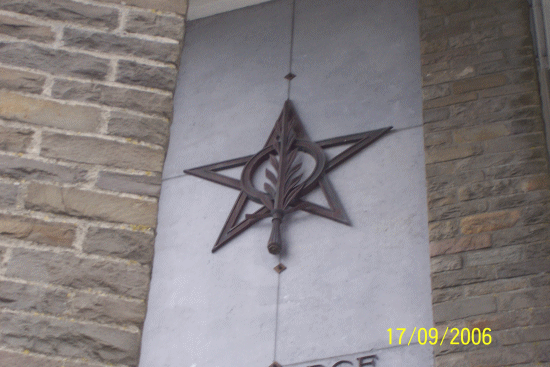 |
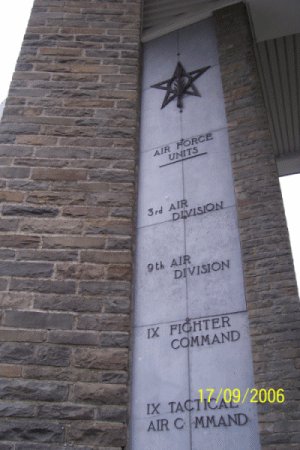 |
Air Force Units
3rd Air Division
9th Air Division
IX Fighter Command
IX Tactical Air Command |
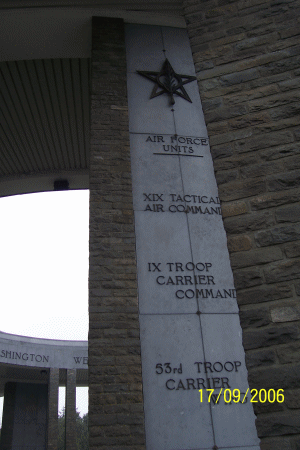 |
Air Force Units
XIX Tactical Air Command
IX Troop Carrier Command
53rd Troop Carrier Wing
|
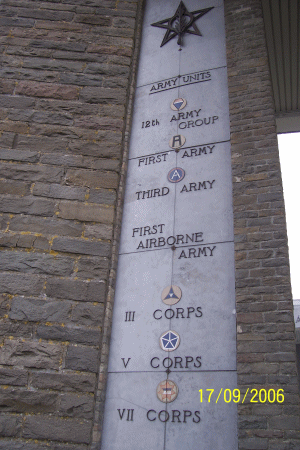 |
Army Units
12th Army Group
First Army
Third Army
First Airborne Army
III Corps
V Corps
VII Corps |
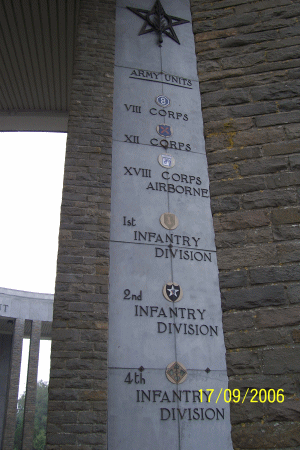 |
Army Units
VIII Corps
XII Corps
XVIII Corps Airborne
1st Infantry Division
2nd Infantry Division
4th Infantry Division
|
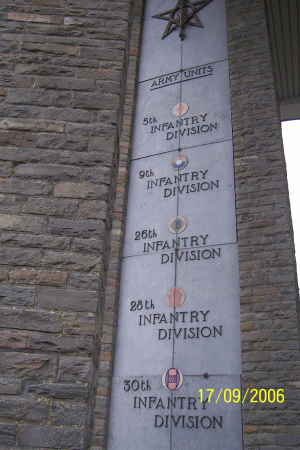 |
Army Units
5th Infantry Division
9th Infantry Division
26th Infantry Division
28th Infantry Division
30th Infantry Division |
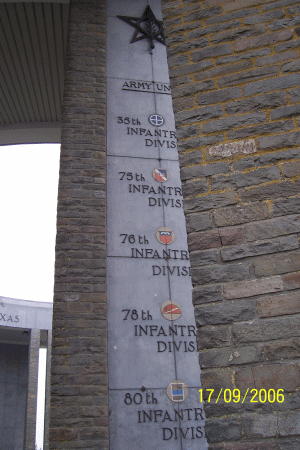 |
Army Units
35th Infantry Division
75th Infantry Division
76th Infantry Division
78th Infantry Division
80th Infantry Division |
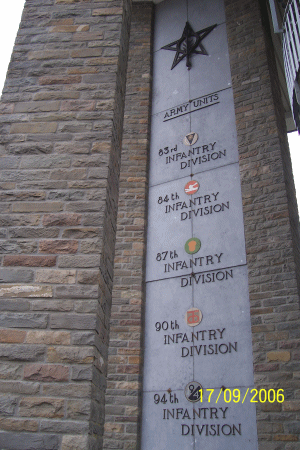 |
Army Units
83rd Infantry Division
84th Infantry Division
87th Infantry Division
90th Infantry Division
94th Infantry Division |
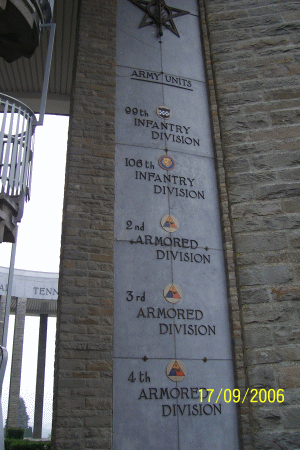 |
Army Units
99th Infantry Division
106th Infantry Division
2nd Armored Division
3rd Armored Division
4th Armored Division |
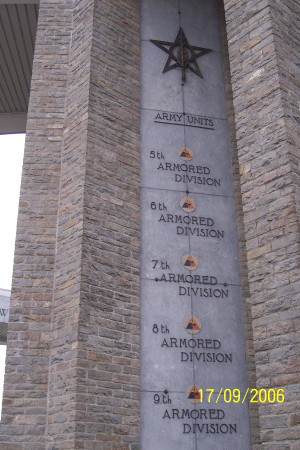 |
Army Units
5th Armored Division
6th Armored Division
7th Armored Division
8th Armored Division
9thArmored Division
|
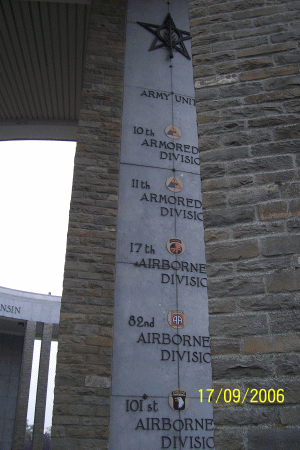 |
Army Units
10th Armored Division
11th Armored Division
17th Airborne Division
82nd Airborne Division
101st Airborne Division
|
 |
This is the Bastogne
Historical Center. In 1945, the war being over at last a
lot of private collectors hurried to gather a lot of
military objects which laid strewn about battlefields.
Nevertheless a large part of these objects left by the two
armies were used by the population to reconstruct, the
people were lacking everything. Those objects were then
lost. Among those collectors, one of them, Guy Franz Arend
managed to preserve a large part of those objects and opened
as early as 1950 the "Bastogne Nuts Museum" in an old house
of the Grand Rue.
Encouraged and helped by the generals who had fought in
Bastogne, notably McAuliffe and von Manteuffel, Mr. Arend
pursued his undertaking and soon settled in the Maison
Siville which was demolished in 1954. It is at that the
museum moved into a building of the Place McAuliffe, which
was named Place du Carré before 1954.
The collections of the museum kept growing richer thanks
to donations made by collectors and veterans as well as
thanks to the constant research made by Mr. Arend. |
| In 1965, the latter received permission
to build a museum next to the Memorial of the Mardasson, on
a piece of land owned by the tourist office of Bastogne.
Keen negotiations between the originator, the tourist office
and the City of Bastogne delayed the project for 10 years.
Finally the tourist office of Bastogne built the star-shaped
building, realized according to Mr. Arend's ideas and plans
and intended to receive his collections.
The new museum, named Bastogne Historical Center, was
inaugurated on 31st May 1976 by His Royal Highness, the
prince Albert of Liège, who is now the King Albert II of
Belgium. On that day, Bastogne celebrated the bicentennial
of the United States' independence together with it's
American friends.
In 2000, the tourist office of Bastogne bought the whole
collection of the Bastogne Historical Center to Mr. Arend.
In 2004, significant renovation work was realized in the
museum and in the shop thanks to a subsidy granted by the
Ministry of Tourism. This subsidy notably allowed the museum
to redo the tour of the visit, to equip itself with audio
guides in four languages which, thanks to detailed comments,
allow visitors to understand even better the Battle of the
Bulge. |
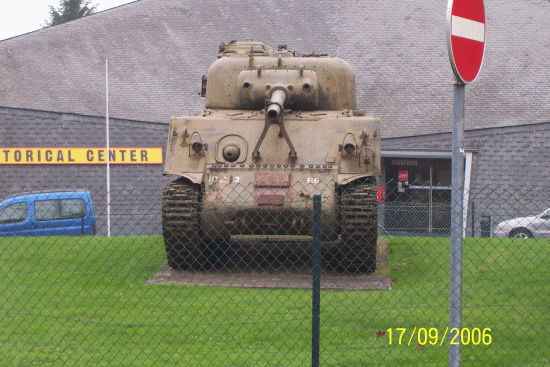 |
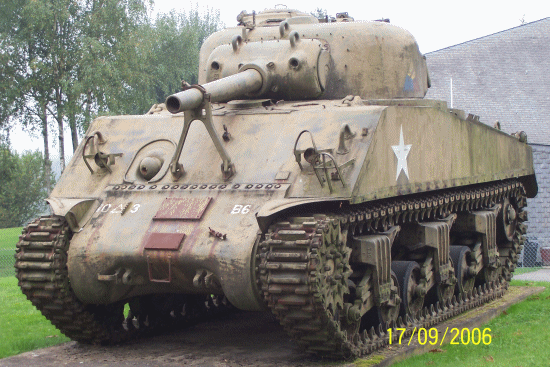 |
Each year the museum welcomes on average
72,000 visitors of every nationalities and every ages. The
Bastogne Historical Center is also the founding member of
the AMBA (Association of the Museums on the Battle of the
Ardennes). The cost of entering the museum is 8,50 Euro
each person.
Inside you can see uniforms, weapons and also the jeep of
General Anthony Clement McAuliffe.
This is a M4A3 Sherman Tank. This Sherman was part of the
11th Armored Division, 41st Tank Battalion, Company B. This
tank have a 105mm canon. |
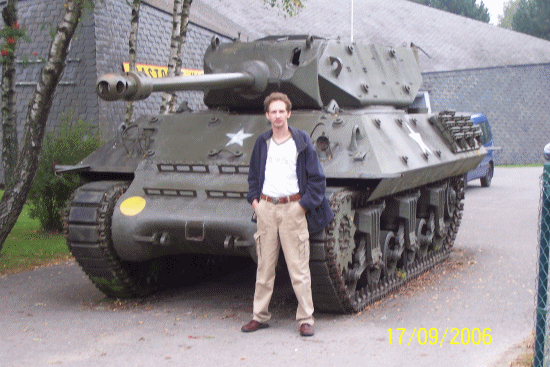 |
This a M-10 Tank Destroyer and it was the first turreted
fully tracked tank destroyer. Production began in September
1942 and the vehicles first entered action in March 1943. A
3 inch gun was mounted in the open topped turret. It's me
in front of
the tank
This was a great day, okay the sky was grey but it was
not raining. I got my souvenirs also 2 mocks with pictures
of this place. Next time when I come back here I will stay a
couple of days and do the walking routes you got here. The
walking routes takes you to the places where the fights
were. Next trip for me is Normandy, when I'm back from
Normandy I will setup a new page and tell my story. Kind
Regards, Pierre |
Soldiers are citizens of death's grey land,
Drawing no dividends from time's tomorrows.
- Siegfried
Sassoon, 'Dreamers' |